From Farm to Screen:
Mickey Mouse and Donald Duck
Mickey Mouse was created as a replacement for Oswald the Lucky Rabbit, an earlier cartoon character created by Walt Disney for Universal Studios. Disney is said to have had the inspiration for his anthropomorphic character from an old pet mouse he had on his farm. Designed by Disney’s partner Ub Iwerks, Mickey debuted in the cartoon Plane Crazy on May 15, 1928. Success came only six months later with Steamboat Willie, one of the first cartoons to feature a soundtrack connected to the action. The mouse became a star of the screen and then of the comic strips. While the drawing and animation were assigned to Arthur Floyd Gottfredson and others, Walt Disney continued scripting, and was the voice actor for both Mickey and Minnie. In total, Mickey starred in more than 150 movies. In 1978, he became the first cartoon character to have a star on the Hollywood Walk of Fame.
Over the last half century, Mickey changed notably, both in his appearance and in character. He was initially a childish and mischievous jokester, but eventually he became more of a virtuous American citizen and self-righteous vindicator, enthusiastically helping the police catch criminals. This is why, according to Michel Pastoureau, “many children (especially in Europe) prefer the much less perfect Donald Duck.” Donald was created in 1934 as a sidekick, and became a full character on his own after 1942.
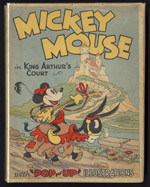 |
Walt Disney Studios. Mickey Mouse in King Arthur’s Court. New York: Blue Ribbon Books, 1933. [zoom] | Additional images: 
This attractive pop-up book with four-color double pages is based upon Mark Twain’s classic novel, A Connecticut Yankee in King Arthur’s Court (1889), the story of a nineteenth-century American who is transported back into early medieval England. |
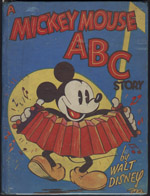 |
Walt Disney. A Mickey Mouse Alphabet Bookand A Mickey Mouse ABC Story. Racine, Wisconsin: Whitman, 1936. [zoom] | Additional images:  
These two “ABC books” provide some keys to Mickey’s huge commercial success, first in America, and then worldwide. He is a positive and always smiling character. He is a charismatic leader who can conduct a whole “symphony band” and teach basic knowledge and values while entertaining. Last but not least, Mickey Mouse is a true “multimedia” character, appearing in cartoons, on the radio, in songs, on TV, and in video games. |
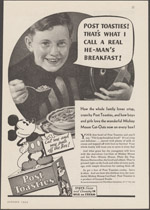 |
Advertisement for “Post Toasties” Breakfast Cereal, 1934. [zoom] Mickey’s cultural adoption was boosted by the efforts of Herman “Kay” Kamen, who oversaw licensing and marketing at the Walt Disney Company from 1932 to 1949. At the height of the Great Depression, General Foods paid a huge sum for the right to put Mickey cut-outs on the back of their cereal boxes, in an effort to target children as consumers. The little mouse sneaked into almost every American home. The rival company, Kellogg’s, responded by expanding its own menagerie: Cornelius Rooster, Tony the Tiger, Toucan Sam, and others would soon rank among the most famous animals in the USA. |
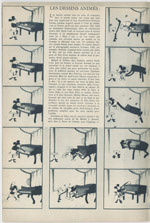 |
“Les dessins animés: Mickey Mouse.” La Petite Illustration. Paris, March 1930. [zoom] | Additional images: 
In this first appearance of Mickey Mouse in France, readers are told what an animated movie is. Mickey had to wear white gloves: readers and spectators had to see the pianist’s hands against his black body. |
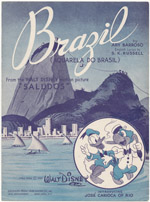 |
Aquarela do Brazil. Musical Score From the Walt Disney Picture “Saludos Amigos,” with Music by Ary Barroso and English Lyrics by S.K. Russell, 1943. [zoom] Just before and during World War II, Disney characters were enrolled in the crusade against Nazism. In 1943, Donald Duck ridiculed Hitler in Der Fuehrer’s Face. The same year, by learning how to dance the samba with a dapper parrot named José Carioca, in a flatteringly pro-Brazil cartoon, Donald helped to keep this country on the side of democracy. |
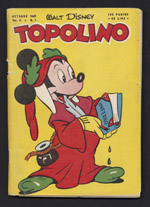 |
L’Inferno di Topolino.Milano: Arnoldo Mondadori, 1949. [zoom] This comic-book adaptation, written by Guido Martina and drawn by Angelo Bioletto, was published in the monthly Topolino from October 1949 to March 1950. This is an interesting example of a local version of Mickey. One historian of Disney comics, Francesco Stajano, has shown that Martina used “high culture” in a funny, non-pedantic way, to make comics “educational in some sense.” Because all schoolboys were required to study La Divina Commedia extensively, Dante made Mickey look respectable to parents. |
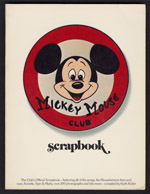 |
Keith Keller. The Mickey Mouse Club Scrapbook. New York: Grosset & Dunlap, 1975. [zoom] | Additional images: 
This album by a Disney fan presents a brief history of television’s famous “Mickey Mouse Club,” and includes information on the long-running American variety television show The Mouseketeers that began in 1955, when Keller was seven. Televised by ABC, it featured an ever-changing cast of teenage performers. At its peak, from 1955-58, the show’s total fan mail reached 360,000 letters. |